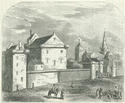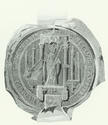 St Kentigern, otherwise known as St Mungo, is usually regarded as the first bishop of Glasgow, having founded a community, possibly beside the Molendinar Burn. Nothing is known of his successors after his death, but as the area was Christian it must have had a bishop. In the early 12th century the future David I of Scotland nominated his chaplain as bishop and thereafter there was a continuous succession with a cathedral consecrated in 1136.
St Kentigern, otherwise known as St Mungo, is usually regarded as the first bishop of Glasgow, having founded a community, possibly beside the Molendinar Burn. Nothing is known of his successors after his death, but as the area was Christian it must have had a bishop. In the early 12th century the future David I of Scotland nominated his chaplain as bishop and thereafter there was a continuous succession with a cathedral consecrated in 1136.
 The bishopric survived a long campaign by the archbishops of York to subject the Scottish bishops to their authority. But in 1175 the Pope declared the see (bishopric) of Glasgow to be a "special daughter" of the Holy See, that is, subject directly to Rome, a privilege later extended to the whole of the Scottish Church. Around 1178, Bishop Jocelin, who was responsible for a substantial extension of the cathedral, procured a charter from King William the Lion giving Glasgow the trading rights of a burgh.
The bishopric survived a long campaign by the archbishops of York to subject the Scottish bishops to their authority. But in 1175 the Pope declared the see (bishopric) of Glasgow to be a "special daughter" of the Holy See, that is, subject directly to Rome, a privilege later extended to the whole of the Scottish Church. Around 1178, Bishop Jocelin, who was responsible for a substantial extension of the cathedral, procured a charter from King William the Lion giving Glasgow the trading rights of a burgh.
 The area of the bishop's authority was large: from north of Loch Lomond to the English border, and from the Cumbraes to Sprouston, near Kelso. The bishop had immense secular as well as spiritual power, with his own courts like a feudal lord. He was assisted in administration by two archdeacons, one responsible for Glasgow and the North, and (from 1238) the other for the southern part, known as Teviotdale. These areas were divided into smaller areas under a dean of Christianity and by 1270 these in turn were subdivided into parishes. It was the Bishop who also selected the provost and the bailies to administer the town.
The area of the bishop's authority was large: from north of Loch Lomond to the English border, and from the Cumbraes to Sprouston, near Kelso. The bishop had immense secular as well as spiritual power, with his own courts like a feudal lord. He was assisted in administration by two archdeacons, one responsible for Glasgow and the North, and (from 1238) the other for the southern part, known as Teviotdale. These areas were divided into smaller areas under a dean of Christianity and by 1270 these in turn were subdivided into parishes. It was the Bishop who also selected the provost and the bailies to administer the town.
 The extent to which the bishops were essentially local princes was clear when in the 1420s Bishop Cameron brought a new grandeur to the office with the completion of a large Bishop's Palace. One of his successors, Bishop Turnbull, was responsible for the foundation of the University in 1451.
The extent to which the bishops were essentially local princes was clear when in the 1420s Bishop Cameron brought a new grandeur to the office with the completion of a large Bishop's Palace. One of his successors, Bishop Turnbull, was responsible for the foundation of the University in 1451.
Glasgow was made subject to the new archbishopric of St Andrews in 1472, but in 1492 it was created a separate archbishopric. In the years before the Reformation, Archbishop Gavin Dunbar (1522-47) and Archbishop James Beaton (1547-60) battled in vain against what they saw as the heresy of advancing Protestantism and against the desire of leading inhabitants for a greater say in the running of their town.